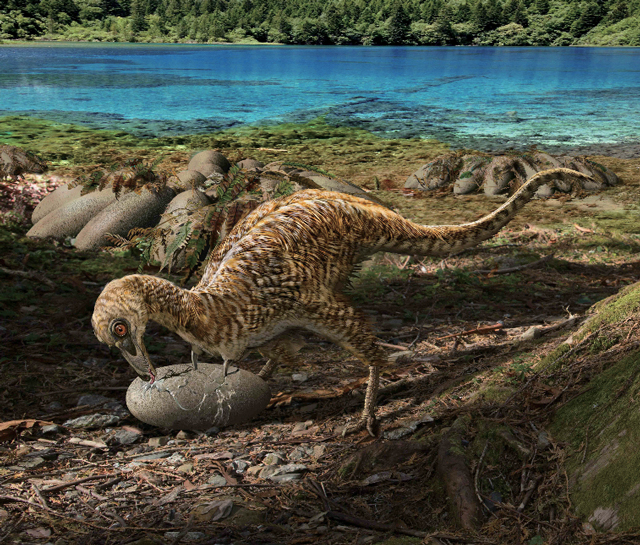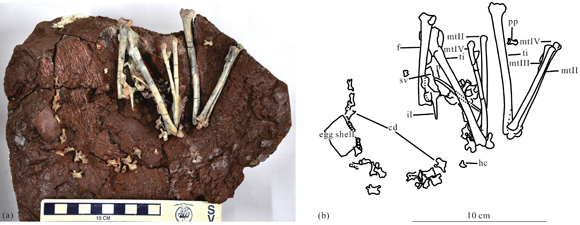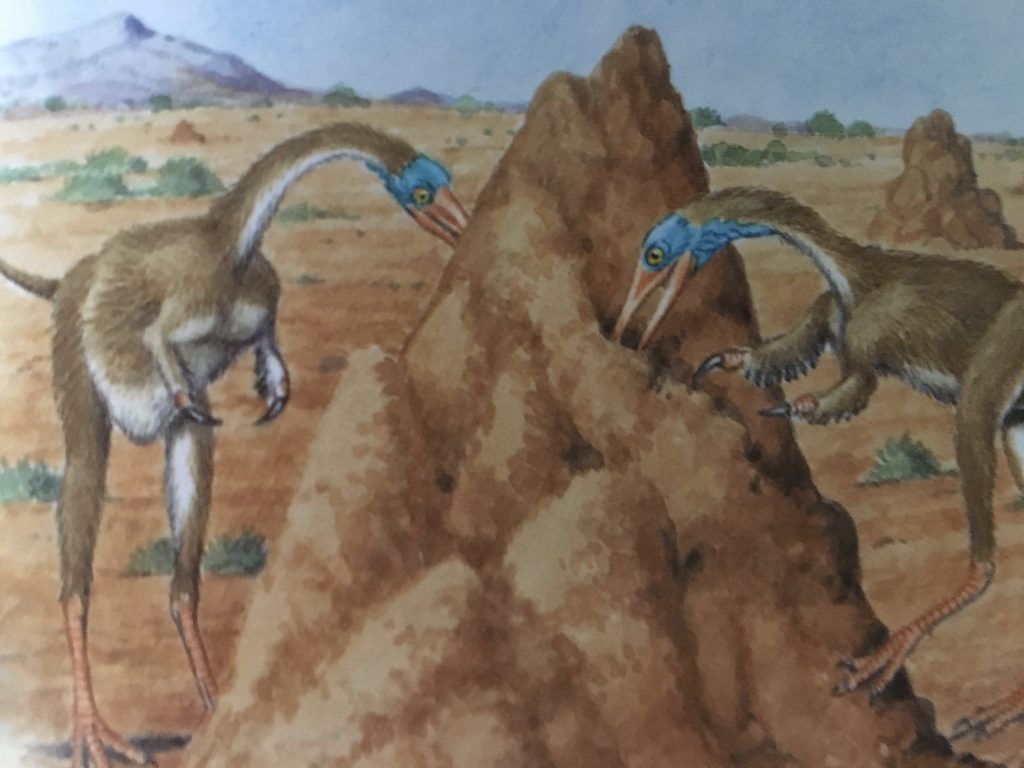Qiupanykus zhangi – Is This Evidence of Egg-eating Dinosaurs?
A team of scientists including researchers from the Chinese Academy of Sciences, Henan Geological Museum and Lanzhou University, have published a paper announcing the discovery of a new species of dinosaur. The little animal that might have weighed around half a kilogram, has been named Qiupanykus zhangi and it has been classified as an alvarezsaurid, a group of bizarre, small, long-legged dinosaurs with highly specialised arms.
Eggshell fragments found close to the remains of the dinosaur’s tail, have thrown up the intriguing possibility that alvarezsaurids with their stocky arms and robust single claw, could have used their highly adapted limbs to break open the eggs of other dinosaurs and therefore these dinosaurs may have been specialist egg-eaters (ovivores).
A Life Reconstruction of the Newly Described Qiupanykus zhangi Breaking Open Dinosaur Eggs

Picture credit: Zhao Chuang
The Youngest Alvarezsaurid from China (Qiupanykus zhangi)
The fossil consisting of the rear portions of the skeleton of an individual was found in Guanping, Qiupa town in the Luanchuan County of Henan Province (central China). Although the bones are poorly preserved, fossilised elements include most of the hind limbs, part of the hips some bones from the neck and twenty-five bones from the tail (caudal vertebrae). Named specimen 41HIII-0101, it was excavated from Upper Cretaceous deposits (Late Maastrichtian faunal stage) of the Qiupa Formation. Qiupanykus is the youngest member of the Alvarezsauridae known from China so far described. The paper describing the fossil specimen has been published in the journal “China Geology”.
A View of the Fossils of Q. zhangi and an Accompanying Line Drawing

Picture credit: China Geology
The Enigmatic Alvarezsauridae
The Alvarezsauridae are a geographically widespread family of very bird-like theropod dinosaurs. Alvarezsaurid fossils have been found in Mongolia, China, as well as North and South America. They seem to have had a wide temporal distribution too, with the earliest known genera being excavated from Upper Jurassic strata in China. When first studied, these little, fast-running dinosaurs were thought to have been flightless birds, but as more fossil remains were found they were re-classified as non-avian dinosaurs. These dinosaurs have presented palaeontologists with a mystery.
Their stubby arms and single, massive, hypertrophied claw indicate an adaptation to a specialised lifestyle. Perhaps, they used their strong arms and their large claw for digging out burrows, some scientists have suggested that these dinosaurs were specialised insect eaters and they used their powerful front limbs to break into the mounds of termites.
A Pair of Alvarezsaurids Break Into a Termite Mound

Picture credit: Dougal Dixon
Did Qiupanykus zhangi Eat Eggs?
The discovery of an eggshell fragment in close proximity to the skeleton led the researchers to speculate on a possible link between Qiupanykus and egg eating. The team ruled out that the egg might have been laid by Qiupanykus as they calculated that it was too small to have laid such a large egg and the eggshell resembled the shell of an oviraptorid dinosaur egg.
In 2012, Everything Dinosaur reported upon the discovery of a pair of eggs found in association with another alvarezsaurid from South America (Bonapartenykus ultimus), in the subsequent scientific paper, the researchers did comment as to the parentage of the eggs, they might have been laid by an oviraptorosaurid dinosaur.
When discussing the discovery of an eggshell fragment very close to the tail bones of Qiupanykus zhangi the research team provide three possible explanations:
- Fragments of eggshell were buried by chance alongside the remains of Q. zhangi the finding of the eggshell in association with a dinosaur skeleton is just coincidence.
- The eggshell comes from an egg laid by an alvarezsaurid dinosaur, it was part of a brood.
- The eggshell fragments were from eggs broken by alvarezsaurid dinosaurs and the eggs were not laid by them.
Given the specialised limbs and the strong, robust thumb claw of alvarezsaurids it is possible that these dinosaurs used their specialised arms and claws to crack open the eggs of other tetrapods and as such alvarezsaurid dinosaurs were not insectivores digging into termite mounds but instead fed upon eggs (ovivores).
To read Everything Dinosaur’s 2012 article about Bonapartenykus ultimus: Alvarezsaurid Eggs Uncovered In Patagonia.
To read Everything Dinosaur’s recent article that looks at fossil discoveries that are helping to map the evolution of the specialised arms of alvarezsaurids: Two New Chinese Dinosaurs Prove Handy.
Visit the Everything Dinosaur website: Everything Dinosaur.






Leave A Comment